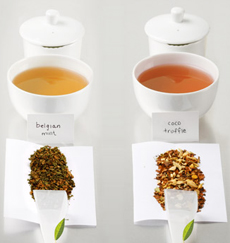TIP OF THE DAY: Dessert Tea
|
|
Many people enjoy a cup of tea with dessert. But what exactly is dessert tea? Dessert tea is a relatively new addition to the tea repertoire. It sprouted up with the green tea and white tea push a decade ago. Many non-tea drinkers wanted the antioxidant benefits of tea but didn’t like the taste of plain green and white tea (which don’t taste great with milk and sugar). So tea blenders started blending green tea, and then white tea, with any number of ingredients that provided flavor and a hint of sweetness: fruits and nuts; butterscotch, caramel and chocolate extracts; flowers (hibiscus, jasmine, rose, saffron); plus cinnamon, mint, vanilla and other flavorings. At a certain point, one producer saw these nearly-calorie-free flavored teas as appropriate for dessert or as a guilt-free sweet beverage; and “dessert teas” were born. |
|
|
Dessert teas are made with black, green, oolong, puer and white teas, and rooibos (herbal “red” tea). You can drink them with dessert, instead of dessert, or at any time of day, plain or with milk and/or sugar. Flavored Teas Are As Old As “Tea” Dessert teas are seen as expanding the tea-buying market by appealing to the non-tea-drinker with mass-appeal flavors common in soft drinks and flavored lattes. The concept is not new—only the name and the marketing of the tea for “dessert.” Since the dawn of man-made fire and vessels, teas were steeped from many barks, berries, leaves and roots. Before tea arrived in Europe in the 17th century (coffee also arrived then, in 1615, along with hot chocolate), this is what was drunk. Today, “tea” refers specifically to brewed leaves of the Camellia sinensis plant, or tea bush. “Herbal tea” is called a tisane in the industry (the word originated with the Greek word ptisane, a drink made from pearl barley). More about tea.
|
||



